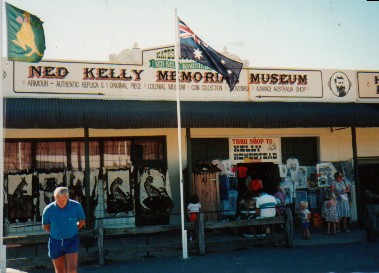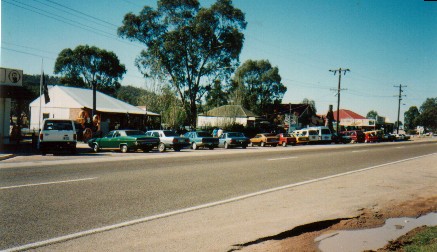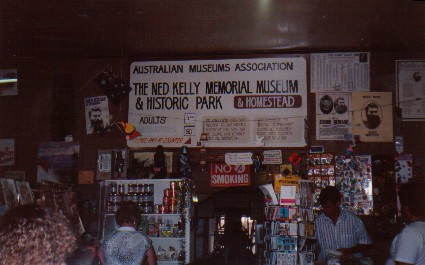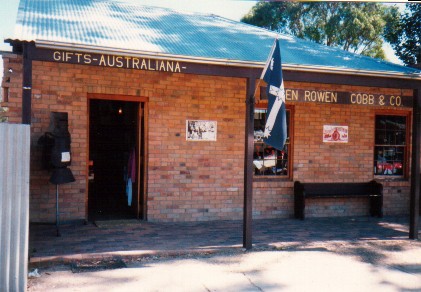|
Glenrowan
is in a unique position in Australia in that it trades almost
exclusively on the memory of a long gone historical figure
.
“A
criminal actually, if you want to be forensic about it. A murderer
hanged in Melbourne in 1880, almost 26.A bushranger by necessity. But
first a rebel. The last great outlaw.”
The
only other town that comes to mind as being remotely similar would be
Tombstone in Arizona-the heartland of Americas Wild West. Here, the
frontier figures of Wyatt Earp and “Doc” Holliday come to life and
celebrate a gunfight (OK Corral) that lasted 40 seconds at the most.
Whilst
Ned looms large over the town, this section also looks at other aspects
of the town including a VERY brief history. I have had a love and
respect for Glenrowan for many years and in a way, this is just my
personal tribute.
Glenrowen,
as it was originally spelt, was named after James Hutton Rowan and
George Christian Rowan. In 1842, these two pioneers took up 162,560
acres and called the run “Peechelbar”. In 1846,they acquired a
further 166000 acres christened Rowan springs.
In
March of 1857, the first 3 sections of the township of Glenrowan
was surveyed by J.Wilmot, the assistant district surveyor. In
March 1867, a further 9 sections including the railway station were
surveyed by Thomas Nixon, the main district surveyor. Glenrowan and
Benalla were proclaimed towns on the same day, 25th February
1861.
For
information about the history of Policing in Glenrowan, please refer to
Senior Constable Birthesels excellent essay on Gary Deans “Ned Kellys
World” site.

Fifteen
years before Ned had his Last Stand in Glenrowan, another bushranger
visited. Daniel Morgan was in the region in 1865 when the township was
only four years old. From there, he went onto Peechelba and to meet his
death. Today,his grave can be seen in Wangaratta cemetery.
As
a settlement, Glenrowan made little progress until it came to life a
decade after being proclaimed with the arrival of the north eastern
railway. With the coming of the rail builders ,the town surged into life
,but after the line was opened for traffic in 1873, the town settled
into a quieter existence.
Until
the Kellys called in June 1880.
There
are trees still alive @ Glenrowan that were flourishing in
not only the days of Ned but would have witnessed the passing of
Hume and Hovell and perhaps been alive when Captain Cook first sited our
coast line. The ancient trees are the “Xanthorhoea Australis” –the
giant grass trees. Although not unique to the Warby ranges, they grow to
respectable heights (over 3 metres), and live from 250-300 years. So
there you go. A surviving living link to the events in June 1880 all
those years ago.

Gold
was discovered in the Glenrowan quarries on November 5th
1906. It was announced, not surprisingly, that the carting of stone had
been stopped. Obviously, nothing much came of it.
Constable
Roach of Glenrowan arrested the culprit for the hellish bushfires of
January 1916. Greta, Laceby, Oxley and South Wangaratta were all
battling for survival. It turned out to be a young Russian swagman who
was aquitted due to the fact he had “started fire accidentally.”
Glenrowan
is also justly famous for it’s wineries. One of the bigger names in
the region is “BAILEYS” in the foothills of the Warby ranges near
Taminick. The full bodied flavour of the Reds is due to the unique soil
structure. The depth of soil averages almost 10 metres and its
composition of red granite, which gives good drainage in winter and
excellent water retention in the summer contribute to fine wines. This
band of soil occurs in only a very small area at the foot of the Warby
ranges and is supposedly unique in Australia.
Varley
Bailey planted the vineyard in 1866, producing the first vintage in
1870. Winery and vineyard antiques from the property have been collected
and put on exhibition.
1970
was a unique year for Glenrowan in that tourism was kicked off in a
spectacular way. The Glenrowan Hall presented the world premier of Tony
Richardsons “Ned Kelly” film starring Mick Jagger. Despite the fact
it was actually filmed in New South Wales, it was considered appropriate
the premiere take place in the heart of Kelly Country. It was just a
pity it wasn’t a better film. While strong in spirit, Mick Jagger did
not have the physical characteristics a convincing Ned
needed. In fact, the portrayal gained a lot of laughs that night.
The biggest one came when the wimpy Jagger was supposed to have
prevailed in the bootmakers shop against so many police.
Although
the script by Ian Jones was accurate, the initial black and white
sequences showed Ned getting married, putting a lot of Kelly purists
into a tailspin. Perhaps Gary Dean, proprietor of Cobb and Co.
souveniers and museum @ Glenrowan can help out with this one as he
claims to have information on Ned Kellys Wedding.
Speaking
of film, very soon, if not already, Heath Ledger will be re-treading
ground used by the gang as he becomes Ned for the film “Our
Sunshine”. It will be lensed in the Warby ranges, not far from
Glenrowan followed by studio work in Melbourne. Let’s hope he does a
better job than Mick.
Don
Tibbits,a former Melbourne printer, was the trail blazer in terms of
Glenrowan tourism. Due to the relative success of the film, attitudes
had somewhat softened. In 1972, Don and his wife Valda built The
Glenrowan Tourist Centre. The prime exhibit was the McDonnells Hotel
Railway bar. All available Kelly books of the day were available within,
as was every conceivable type of souvenier fron posters to Kelly Gang
lolly pops.
The
Ned Kelly statue adjacent to “Billy Tea Rooms”
also
made its debut…”symbolically ordering tourists to stop and come in
to buy”. Over the years, the statue was stolen and re-covered only to
finally disappear in late 1987 for good. A plastic statue of the singer
“Lazy Harry” now occupies the bluestone pedestal. Not quite the
same.
In
1977, the council changed the name of some Glenrowan street names so
they had a good authentic tourist ring. Now, you can drive down Ned St,
Siege St, Kate St. and Kelly St. At least we haven’t got a Steele St,
Hare Ave. or Nicholson Place though I guess.

There
was uproar in the town in the late 1980’s First of all, the Hume
Freeway by-passed the town, then, to add insult to injury, it was
announced that VicRoads were building a major service centre on the
freeway on the Wangaratta side of Glenrowan. Although business was quiet
initially with the only real casualty being Max Burgin and his Service
Station, business soon boomed again thanks in part to promotion signs
erected on freeway advertising Ned Kelly and the town. I can’t speak
for anyone else, but I would prefer a homemade meat pie and sauce from
the “Billy Tea Rooms” in Glenrowan than anything from McDonalds @
the service centre on the freeway.But that’s just me!
Another
substantial affair in Gladstone St, Glenrowans Main St. and the old
section of the Hume Highway, is “Kates Cottage.”Originally
established by Nannette Green-the instigator of the excellent Kelly
Homestead replica @ rear of property, today business is run by Chris and
Rod Gerrett. Currently under going a renovation, I look forward to
seeing finished product. It will be a worthy memorial to the Kellys and,
fittingly, in their heartland of Glenrowan.
Now
that we seem to be in a Golden Age of Ned information, let’s hope we
see some excellent things in Glenrowan and surrounds in the coming
years.
 
|
